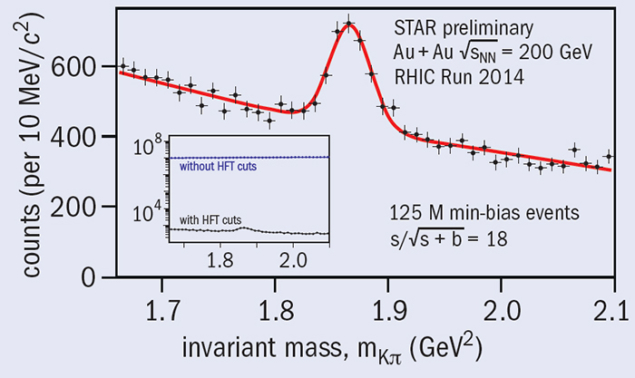
Image credit: Berkeley Lab/Roy Kaltschmidt.
Heavy quarks are important probes of the quark–gluon plasma that is produced when relativistic heavy ions collide. Because of a mass effect, it has been argued that heavy quarks lose less energy through gluon radiation than light quarks as they traverse the medium. However, studying heavy quarks in a particle-dense environment is challenging. Moreover, the physics interest is in bulk behaviour of charm quarks, so it is important to study charmed hadron production over the full range of momentum. At low momenta, multiple scattering is very important, and this places strict constraints on the amount of material in the detector.
The STAR Heavy Flavour Tracker (HFT) was built to meet these challenges. Installed in the STAR detector at the Relativistic Heavy Ion Collider (RHIC) at Brookhaven National Laboratory early last year, it took data during the 2014 and 2015 running periods. It was specifically designed and constructed to allow for the direct topological reconstruction of heavy-flavour decay vertices such as the D0 (decay distance cτ around 120 μm), by tracking the decay particles through four layers of silicon detectors to extend the STAR physics programme to include fully reconstructed charmed hadrons.

To do this, the tracker incorporated a number of novel features. First, in addition to the two outermost layers of standard-technology silicon strips and pad sensors, the innermost two layers of the HFT – the pixel (PXL) detector (figure 1) – are constructed using monolithic active-pixel sensors (MAPS). This is the first large-scale use at a collider experiment of MAPS technology, which integrates the silicon of the detector and the signal processing on a single silicon die. Second, its novel design, with a low-mass carbon-fibre support structure, aluminum conductor read-out cables (instead of copper) and air cooling (instead of water) gives the PXL a sleek footprint with a very low radiation length – 0.4% per layer – to minimize multiple Coulomb scattering. These features give the detector, which was conceived and built by the Relativistic Nuclear Collisions group at the Lawrence Berkeley National Laboratory (LBNL), excellent pointing capabilities, with a resolution for its distance of closest approach of only 40 μm for 750 MeV/c kaons.
In addition, the detector-support mechanics are designed to allow for very fast insertion and detector replacement. The PXL detector can be inserted, cabled and working in 12 hours. This allows for quick changes if the detector suffers radiation damage.
The MAPS chips were developed by the microelectronics group at the Institut Pluridisciplinaire Hubert Curien in Strasbourg, in collaboration with LBNL, and are the result of a 10 year development process. The sensor design is highly optimized for the RHIC environment. A single sensor features 890,000 pixels, each measuring 20.7 μm × 20.7 μm. The detector integration time is 186 μs, allowing the detector to function at RHIC with a very low occupancy. The fast read-out is achieved with binary output using column-level discriminators and on-chip zero-suppression/data-compression circuitry. The detector’s initial performance is in line with expectations: figure 2 shows an invariant D0 → K–π+ (and conjugate) mass peak, shown at the recent Quark Matter 2015 conference.





